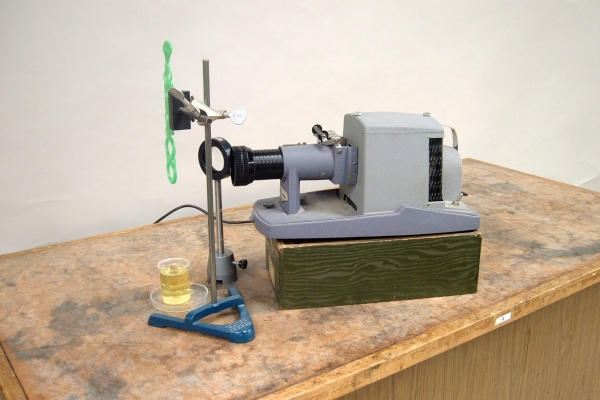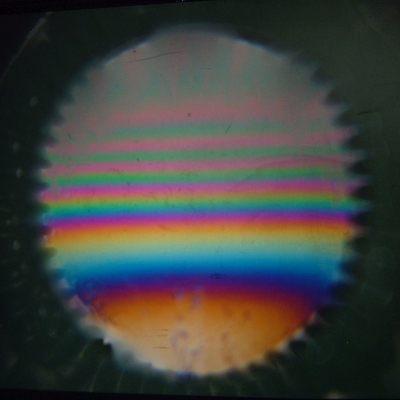 |
 |
The projector illuminates a bubble wand. When you raise the beaker of diluted dish detergent to immerse the wand, then lower the beaker, you leave a film on the wand. A lens focuses the light reflected by the wand and soap film onto a screen, producing an image like the one shown at right. This is a real, inverted image of the soap film, which as gravity pulls it downward, grows thicker at the bottom (top of the image) and thinner at the top (bottom of the image). Eventually, the film grows so thin near the top, that it grows dark (vide infra).
When light encounters the interface between two media whose indices of refraction are different, while most of it passes through the interface, a small portion, typically about four percent, is reflected from it. Thus, as light from the projector passes through the soap film, about 4% is reflected from the front surface, and 4% of the transmitted light is reflected from the back surface. If the light reflected from the back surface of the soap film overlaps with that reflected from the front surface, the two beams of light undergo interference. For the sake of simplicity, we will assume that the light is traveling perpendicular to the soap film. If we call the thickness of the soap film d, then the difference in path length for the light reflected from the back surface with respect to that for the light reflected from the front surface is 2d. Whether the interference is constructive or destructive depends on how many wavelengths of the light fit within this path difference. If we take the index of refraction of air as equal to one, and call the wavelength of the light in air λ, then the wavelength of the light in the soap film is λn = λ/n, where n is the index of refraction of the soap film. In order for light of a particular wavelength to undergo constructive interference, the light reflected from the back surface of the film and that reflected from the front surface must be in phase when they meet at the front surface. When light traveling through a medium is reflected by a second medium that has a higher index of refraction than the first, the light undergoes a 180° phase shift upon reflection. This is analogous to what happens, for example, to a pulse traveling through a string whose density changes suddenly in the middle, when it goes from one half of the string into the denser half. Part of the pulse continues without a change in phase, while the reflected portion is inverted. One can observe this by means of a type of interferometer called Lloyd’s mirror. The behavior of the pattern formed by the soap film as gravity causes it to become very thin, also shows it. As fluid drains from the soap film and it becomes very thin near the top, the bottom of the image darkens. (You can tell that there is still a soap film, either because of tiny bubbles floating in the dark portion, or because the lower part is still visible, which means that the film is still intact.) If the thickness in the dark portion of the film is much smaller than the wavelength of the light, then for the two reflected beams to be out of phase, one must undergo a 180° phase change upon reflection. It is the light reflected from the front surface of the soap film that returns 180° out of phase with the incoming light, while the light reflected from the back surface returns with no change in phase.
For the two reflected beams to be in phase, then, the light traveling through the soap film and back must go a distance equal to some integral number of wavelengths plus or minus one half wavelength, or:
2d = (m + 1/2) λn m = 0, 1, 2, . . ., or
2dn = (m + 1/2)λ m = 0, 1, 2, . . .
For wavelengths of light for which the film thickness satisfies this equation, the reflected light has a maximum intensity. Minimum intensity occurs for
2dn = mλ m = 0, 1, 2, . . .
When you first immerse the wand, a thick, almost uniform soap film forms over the area of the wand, and the light reflected to the screen appears white. As gravity pulls down on the film and fluid drains from it, it tapers, becoming thicker at the bottom and thinner at the top. Thus, d changes from top to bottom, and at different points along the height of the film, different wavelengths of light exhibit interference maxima. Because of this, you observe a series of rainbow stripes, which widen and decrease in number as the film thins. The change in film thickness between successive stripes of a given color is (1/2)(λ/n) for light of that color. As noted above, once the film becomes significantly thinner than one wavelength for any color, it darkens, because all the light now undergoes destructive interference; the film is no longer thick enough to shift the phase change between the reflected beams of light, of any wavelength, significantly from 180°.
References:
1) Sears, Francis Weston and Zemansky, Mark W. College Physics, Third Edition (Reading, Massachusetts: Addison-Wesley Publishing Company, Inc., 1960), pp. 910-14.
2) Halliday, David and Resnick, Robert. Physics, Part Two, Third Edition (New York: John Wiley and Sons, 1977), pp. 1006-7.